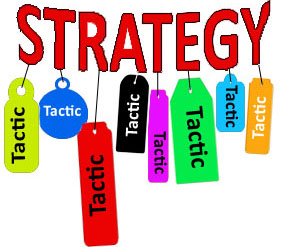In past weeks, we explored the need for a tangible goal and strategies that are measurable as steps toward achievement of your goal. Today, we explore how to create tactics to  accompany each strategy, and even suggest a number of tactics to consider for each strategy.
accompany each strategy, and even suggest a number of tactics to consider for each strategy.
Tactics support strategies and are more short term and procedural than the strategies they support. Tactics change frequently as achieved and may be updated or replaced during a year when achieved, unlike strategies which often span a number of years.
Five tactics to support each strategy seem a fair, even if arbitrary number. Tactics direct each department in very specific ways. Here are several examples of tactics from my recent experience with companies where I serve as board member.
Strategy Three: Expand into at least three new continents through new distribution channels.
[Email readers, continue here…]
- Sign one distributor by June of this year in each of three major geographic areas. EMEA, Asia, Latin America. Each distributor should be capable of generating $1 million in business by year two.
- Assign our development manager to localize design and oversee the needed enhancements to our product and support materials for each new territory.
- Train and transfer technology to each new distributor within 90 days of signing.
- Assign one of our corporate employees to support sales and installation efforts by all distributors.
- Seed demand in each new territory with at least two corporate marketing events in partnership with each distributor.
Note that each of these tactics directly support the strategy, are measurable and assumed to be achievable, bought into by each department affected by the tactic. Note that the strategy calls for cooperation between business development, sales, marketing, product development, installation and support. This is a great way to unify departments that once may have competed for resources toward individual ends, now pointed toward a common goal supported by all levels of management up to the CEO.
Development of these important elements (goal, strategy, tactics) of the plan should be made using all the resources available, from your board of directors to your senior management to departmental management. Getting all to buy into each step may not be easy, but when accomplished, is a powerful and invigorating opportunity to celebrate, then to get to work as a functional unit of the whole.








